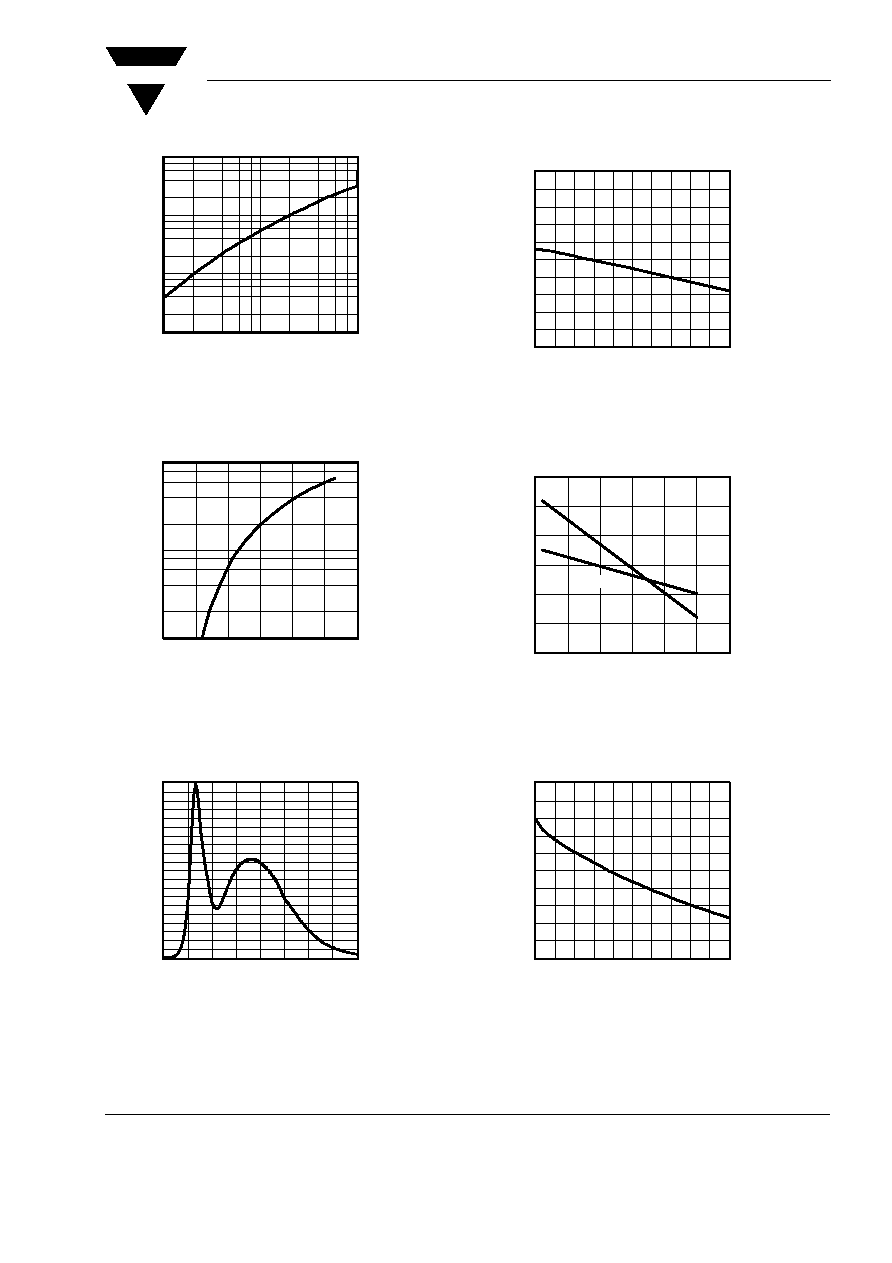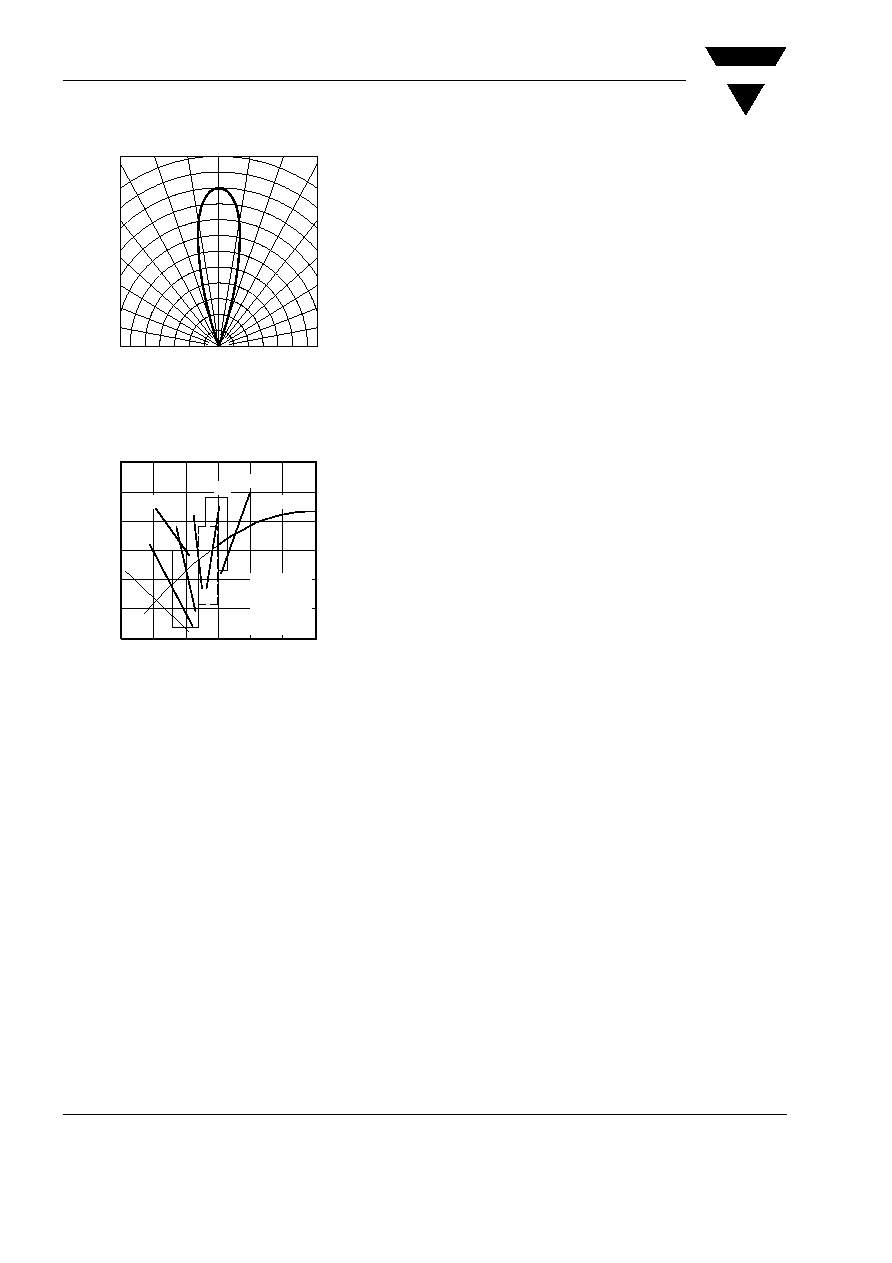 | –≠–ª–µ–∫—Ç—Ä–æ–Ω–Ω—ã–π –∫–æ–º–ø–æ–Ω–µ–Ω—Ç: TLHW490 | –°–∫–∞—á–∞—Ç—å:  PDF PDF  ZIP ZIP |

VISHAY
TLHW490.
Document Number 83161
Rev. 1.2, 31-Aug-04
Vishay Semiconductors
www.vishay.com
1
e2 Pb
Pb-free
19222
White LED in 3mm T 1 Waterclear Package
Description
High Intensity LED with typical color coordinates x =
0.33, y = 0.33 (typical color temperature 5500 k). This
LED emits white light with a high color rendering
index.
The emission spectrum is tuned for ideal white, with-
out the impression of being blue shaded or "cold". The
package is a standard 3mm.
The internal reflector is filled with a compound of TAG
phosphor and an elastic resin.
Therefore the chip is better protected against temper-
ature cycle stress.
The phosphor converts the blue emission of the
InGaN chip partially to amber, which mixes with the
remaining blue to produce white.
Features
∑ High efficient InGaN technology
∑ Chromaticity coordinate categorized according to
CIE1931 per packing unit
∑ Typical chromaticity coordinates x = 0.33; y = 0.33
∑ Typical color temperature 5500 K
∑ ESD class 1
∑ Small viewing angle, high luminous intensity
∑ Chip embedded in elastic resin, improved robust-
ness against temperature cycle stress
∑ Lead-free device
Applications
Indicator and backlighting
Indoor and outdoor message panels
Alternative to incandescent lamps
Marker lights
Parts Table
Absolute Maximum Ratings
T
amb
= 25 ∞C, unless otherwise specified
TLHW490.
Part
Color, Luminous Intensity
Angle of Half Intensity (±
)
Technology
TLHW4900
White, I
V
> 240 mcd
16 ∞
InGaN / TAG on SiC
TLHW4901
White, I
V
= (240 to 860) mcd
16 ∞
InGaN / TAG on SiC
Parameter
Test condition
Symbol
Value
Unit
Reverse voltage
V
R
5
V
DC Forward current
T
amb
50 ∞C
I
F
30
mA
Surge forward current
t
p
10 µs
I
FSM
0.1
A
Power dissipation
T
amb
50 ∞C
P
V
126
mW
Junction temperature
T
j
100
∞C

www.vishay.com
2
Document Number 83161
Rev. 1.2, 31-Aug-04
VISHAY
TLHW490.
Vishay Semiconductors
Optical and Electrical Characteristics
T
amb
= 25 ∞C, unless otherwise specified
White
TLHW490.
1)
in one Packing Unit I
Vmin
/I
Vmax
0.5
Typical Characteristics
(T
amb
= 25
∞C unless otherwise specified)
Operating temperature range
T
amb
- 40 to + 100
∞C
Storage temperature range
T
stg
- 40 to + 100
∞C
Soldering temperature
t
5 s
T
sd
260
∞C
Thermal resistance junction/
ambient
R
thJA
400
K/W
Parameter
Test condition
Part
Symbol
Min
Typ.
Max
Unit
Luminous intensity
1)
I
F
= 20 mA
TLHW4900
I
V
240
500
mcd
TLHW4901
I
V
240
860
mcd
Luminous flux
I
F
= 20 mA
V
250
mlm
Chromaticity coordinate x acc.
to CIE 1931
I
F
= 20 mA
x
0.33
Chromaticity coordinate y acc.
to CIE 1931
I
F
= 20 mA
y
0.33
Angle of half intensity
I
F
= 20 mA
± 16
deg
Forward voltage
I
F
= 20 mA
V
F
3.5
4.2
V
Reverse voltage
I
R
= 10
µA
V
R
5
V
Temperature coefficient of V
F
I
F
= 20 mA
TC
V
- 4
mV/K
Temperature coefficient of I
V
I
F
= 20 mA
TC
I
- 0.5
% / K
Parameter
Test condition
Symbol
Value
Unit
Figure 1. Power Dissipation vs. Ambient Temperature
0
20
40
60
80
100
120
140
T
amb
- Ambient Temperature ( ∞C )
16803
P
-
Power
Dissipation
(
m
W
)
V
0
20
40
60
80
100
Figure 2. Forward Current vs. Ambient Temperature
0
5
10
15
20
25
30
35
I
-
Forward
Current
(
m
A
)
F
T
amb
- Ambient Temperature ( ∞ C )
16804
0
20
40
60
80
100

VISHAY
TLHW490.
Document Number 83161
Rev. 1.2, 31-Aug-04
Vishay Semiconductors
www.vishay.com
3
Figure 3. Relative Luminous Intensity vs. Forward Current
Figure 4. Forward Current vs. Forward Voltage
Figure 5. Relative Intensity vs. Wavelength
0.01
0.1
1
10
1
10
100
I
F
- Forward Current ( mA )
16194
I
-
Relative
Luminous
Intensity
Vrel
1
10
100
2.0
2.5
3.0
3.5
4.0
4.5
5.0
V
F
- Forward Voltage ( V )
16195
F
I
-
Forward
Current
(
m
A
)
0
10
20
30
40
50
60
70
80
90
100
400 450 500 550 600 650 700 750 800
- Wavelength ( nm )
16196
I
-
Relative
Luminous
Intensity
V
rel
Figure 6. Rel. Luminous Intensity vs. Ambient Temperature
Figure 7. Chromaticity Coordinate Shift vs. Forward Current
Figure 8. Forward Voltage vs. Ambient Temperature
0.0
0.2
0.4
0.6
0.8
1.0
1.2
1.4
1.6
1.8
2.0
16197
I
-
Relative
Luminous
Intensity
Vrel
T
amb
- Ambient Temperature ( ∞C )
0 10 20 30 40 50 60 70 80 90 100
0.315
0.320
0.325
0.330
0.335
0.340
0.345
16198
f
-
Chromaticity
coordinate
shift
(x,y)
X
Y
I
F
- Forward Current ( mA )
White
0
60
50
40
30
20
10
3.45
3.50
3.55
3.60
3.65
3.70
3.75
3.80
3.85
3.90
3.95
16199
I
-
Forward
Voltag
e(V)
F
T
amb
- Ambient Temperature (
∞C )
0 10 20
30 40 50 60 70 80 90 100

www.vishay.com
4
Document Number 83161
Rev. 1.2, 31-Aug-04
VISHAY
TLHW490.
Vishay Semiconductors
Figure 9. Rel. Luminous Intensity vs. Angular Displacement
Figure 10. Coordinates of Colorgroups
0.4
0.2
0
0.2
0.4
0.6
95 10044
0.6
0.9
0.8
0∞
∞
∞
30∞
10
20
40∞
50∞
60∞
70∞
80∞
0.7
1.0
I
-
Relative
Luminous
Intensity
v
rel
0.20
0.25
0.30
0.35
0.40
0.45
0.50
0.20
0.25
0.30
0.35
0.40
0.45
0.50
16284
Coordinates of Colorgroups
a = 20000K
b = 10000K
c = 7000K
d = 6000K
e = 5000K
f =
4000K
a
b
c
d
e
f
3
4
5
.
.
A
D65
Coordinates
of
Colorgroups

VISHAY
TLHW490.
Document Number 83161
Rev. 1.2, 31-Aug-04
Vishay Semiconductors
www.vishay.com
5
Package Dimensions in mm
16811

www.vishay.com
6
Document Number 83161
Rev. 1.2, 31-Aug-04
VISHAY
TLHW490.
Vishay Semiconductors
Ozone Depleting Substances Policy Statement
It is the policy of Vishay Semiconductor GmbH to
1. Meet all present and future national and international statutory requirements.
2. Regularly and continuously improve the performance of our products, processes, distribution and
operatingsystems with respect to their impact on the health and safety of our employees and the public, as
well as their impact on the environment.
It is particular concern to control or eliminate releases of those substances into the atmosphere which are
known as ozone depleting substances (ODSs).
The Montreal Protocol (1987) and its London Amendments (1990) intend to severely restrict the use of ODSs
and forbid their use within the next ten years. Various national and international initiatives are pressing for an
earlier ban on these substances.
Vishay Semiconductor GmbH has been able to use its policy of continuous improvements to eliminate the
use of ODSs listed in the following documents.
1. Annex A, B and list of transitional substances of the Montreal Protocol and the London Amendments
respectively
2. Class I and II ozone depleting substances in the Clean Air Act Amendments of 1990 by the Environmental
Protection Agency (EPA) in the USA
3. Council Decision 88/540/EEC and 91/690/EEC Annex A, B and C (transitional substances) respectively.
Vishay Semiconductor GmbH can certify that our semiconductors are not manufactured with ozone depleting
substances and do not contain such substances.
We reserve the right to make changes to improve technical design
and may do so without further notice.
Parameters can vary in different applications. All operating parameters must be validated for each
customer application by the customer. Should the buyer use Vishay Semiconductors products for any
unintended or unauthorized application, the buyer shall indemnify Vishay Semiconductors against all
claims, costs, damages, and expenses, arising out of, directly or indirectly, any claim of personal
damage, injury or death associated with such unintended or unauthorized use.
Vishay Semiconductor GmbH, P.O.B. 3535, D-74025 Heilbronn, Germany
Telephone: 49 (0)7131 67 2831, Fax number: 49 (0)7131 67 2423





